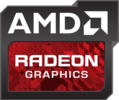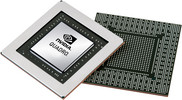AMD Radeon Pro WX 2100 vs NVIDIA Quadro P3000 Max-Q vs NVIDIA Quadro P4200
AMD Radeon Pro WX 2100
► remove from comparison
The AMD Radeon Pro WX 2100 Mobile is a professional workstation graphics card for laptops. It is based on the consumer Radeon RX 540X and therefore uses the same Polaris 12 chip (unverified). The exact clock speeds of the mobile version are not published, the desktop version however, seems to feature similar clock speeds as the RX 540X.
The AMD Radeon Pro (formerly known as FirePro) is the counterpart to the Quadro series from Nvidia and offers certified drivers for professional 3D applications (CAD and DCC).
For more information on the features and specifications of the Polaris architecture, visit our in depth article here.
NVIDIA Quadro P3000 Max-Q
► remove from comparison
The Nvidia Quadro P3000 Max-Q (official Nvidia Quadro P3000 with Max-Q Design) is a mobile high-end workstation graphics card for notebooks. Similar to the consumer GeForce GTX 1060 (Laptop), it is based on the GP106 chip with 1280 shaders. The graphics card is the more efficient version of the normal Quadro P3000 with slightly reduced clock speeds at a much reduced power consumption (60 Watt versus 75 Watt TGP).
The Quadro GPUs offer certified drivers, which are optimized for stability and performance in professional applications (CAD, DCC, medical, prospection, and visualizing applications). The performance in these areas is therefore much better compared to corresponding consumer GPUs.
Performance
The theoretical performance should be only slightly below the normal Quadro P3000 (as it was with the Max-Q GTX 1060 versus the normal GTX 1060).
NVIDIA Quadro P4200
► remove from comparison
The Nvidia Quadro P4200 is a mobile high-end workstation graphics card for notebooks. It is based on the GP104 chip (like the consumer GeForce GTX 1070 or 1080 for laptops) and features 2304 shader cores. The clock rate is not disclosed but the theoretical SP performance is rated at 8.9 TFLOPs (for the fast Max-P version) and therefore faster than the old Quadro P5000 but below the Quadro P5200 (see table below). The P4200 is equipped with 8 GB GDDR5 which leads to 224 GB7s peak bandwidth due to the 256 Bit memory bus. There are two variants available, a Max-P performance version and a Max-Q version tuned for efficiency (with lower clock speeds).
The Quadro GPUs offer certified drivers, which are optimized for stability and performance in professional applications (CAD, DCC, medical, prospection, and visualizing applications). The performance in these areas is therefore much better compared to corresponding consumer GPUs.
Power Consumption
The power consumption of the Quadro P4200 is rated at 115 Watt TGP (max power consumption incl. memory) and therefore 15 Watt more than the Quadro P5000. The card is therefore best suited for large 17-inch notebooks.
| AMD Radeon Pro WX 2100 | NVIDIA Quadro P3000 Max-Q | NVIDIA Quadro P4200 | ||||||||||||||||||||||||||||||||||||||||||||||||||||||||||||||||||||||||||||||||||||||||||||||
| Quadro P Series |
|
|
| |||||||||||||||||||||||||||||||||||||||||||||||||||||||||||||||||||||||||||||||||||||||||||||
| Codename | Polaris 12 | N17E-Q1 Max-Q | ||||||||||||||||||||||||||||||||||||||||||||||||||||||||||||||||||||||||||||||||||||||||||||||
| Architecture | Polaris | Pascal | Pascal | |||||||||||||||||||||||||||||||||||||||||||||||||||||||||||||||||||||||||||||||||||||||||||||
| Pipelines | 512 - unified | 1280 - unified | 2304 - unified | |||||||||||||||||||||||||||||||||||||||||||||||||||||||||||||||||||||||||||||||||||||||||||||
| Core Speed | 1219 (Boost) MHz | 1075 - 1240 (Boost) MHz | 1215 - 1480 (Boost) MHz | |||||||||||||||||||||||||||||||||||||||||||||||||||||||||||||||||||||||||||||||||||||||||||||
| Memory Speed | 6000 MHz | 7008 MHz | 7132 MHz | |||||||||||||||||||||||||||||||||||||||||||||||||||||||||||||||||||||||||||||||||||||||||||||
| Memory Bus Width | 128 Bit | 192 Bit | 256 Bit | |||||||||||||||||||||||||||||||||||||||||||||||||||||||||||||||||||||||||||||||||||||||||||||
| Memory Type | GDDR5 | GDDR5 | GDDR5 | |||||||||||||||||||||||||||||||||||||||||||||||||||||||||||||||||||||||||||||||||||||||||||||
| Max. Amount of Memory | 2048 MB | 16 GB | 8 GB | |||||||||||||||||||||||||||||||||||||||||||||||||||||||||||||||||||||||||||||||||||||||||||||
| Shared Memory | no | no | no | |||||||||||||||||||||||||||||||||||||||||||||||||||||||||||||||||||||||||||||||||||||||||||||
| API | DirectX 12, OpenGL Vulkan | DirectX 12_1, Shader 5.0, OpenGL 4.5 | DirectX 12_1, Shader 5.0, OpenGL 4.5 | |||||||||||||||||||||||||||||||||||||||||||||||||||||||||||||||||||||||||||||||||||||||||||||
| Power Consumption | 50 Watt | 60 Watt | 115 Watt | |||||||||||||||||||||||||||||||||||||||||||||||||||||||||||||||||||||||||||||||||||||||||||||
| technology | 14 nm | 16 nm | 16 nm | |||||||||||||||||||||||||||||||||||||||||||||||||||||||||||||||||||||||||||||||||||||||||||||
| Features | DisplayPort 1.3 HBR / 1.4 HDR Ready, HDMI 2.0, AMD FreeSync | Optimus, PhysX, 3D Vision Pro, nView, Optimus | Optimus, PhysX, 3D Vision Pro, nView, Optimus | |||||||||||||||||||||||||||||||||||||||||||||||||||||||||||||||||||||||||||||||||||||||||||||
| Notebook Size | large | large | large | |||||||||||||||||||||||||||||||||||||||||||||||||||||||||||||||||||||||||||||||||||||||||||||
| Date of Announcement | 21.03.2018 | 01.09.2017 | 07.05.2018 | |||||||||||||||||||||||||||||||||||||||||||||||||||||||||||||||||||||||||||||||||||||||||||||
| Link to Manufacturer Page | www.amd.com |


 Deutsch
Deutsch English
English Español
Español Français
Français Italiano
Italiano Nederlands
Nederlands Polski
Polski Português
Português Русский
Русский Türkçe
Türkçe Svenska
Svenska Chinese
Chinese Magyar
Magyar